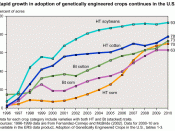The potential benefits of genetic engineering and research are well known. Scientists are excited a out the prospects for new medications, new agricultural crops, and new means of solving environmental problems. On the other hand, the potential risks of genetic engineering are also well recognized. Scientists have been long aware that there can be unwanted side effects, unanticipated social costs and, and unseen public health and environmental risks. Theses concerns early on caused scientists to put in action a suspension on certain classes of recombinant DNA experiments. Meaning, it was the scientists themselves who evaluated the risks first.
As a result of the concern for regulation of research, national guidelines for DNA experimental work were written in 1975 and adopted by the National Institute of Health (NIH). They set up a Recombinant DNA Advisory Committee to monitor DNA research. All private and public DNA researchers follow the guidelines set up by this committee.
The products of genetic engineering are also regulated by government agencies, coordinated by the White House Office of Science and Technology Policy. Various agencies are responsible for approving and regulating the use of products that area developed. For example, the USDA was given authority to oversee all applications for the introduction and sale of genetically engineered plants. The EPA regulates experiments with microbial pesticides. The FDA regulates all human or animal drugs produced through genetic engineering. The FDA's policy is as follows: genetically engineered foods will not carry labels stating that they have been engineered, now will the government keep track of foods that have been engineered. As a result, neither the government nor consumers will know which whole nor processed foods have been genetically engineers. This leads many people to believe that the regulation for engineered products is not adequate. The basis for the...


